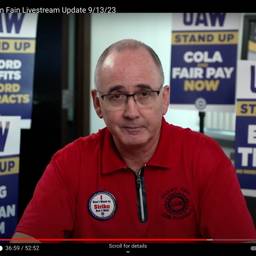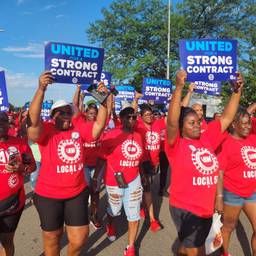Exhausted, Injured and Angry: Autoworkers Have Had Enough
Record profits should mean record pay—but that’s not how it’s played out at the Big Three automakers. These Ford workers have had enough.
Sarah Lazare
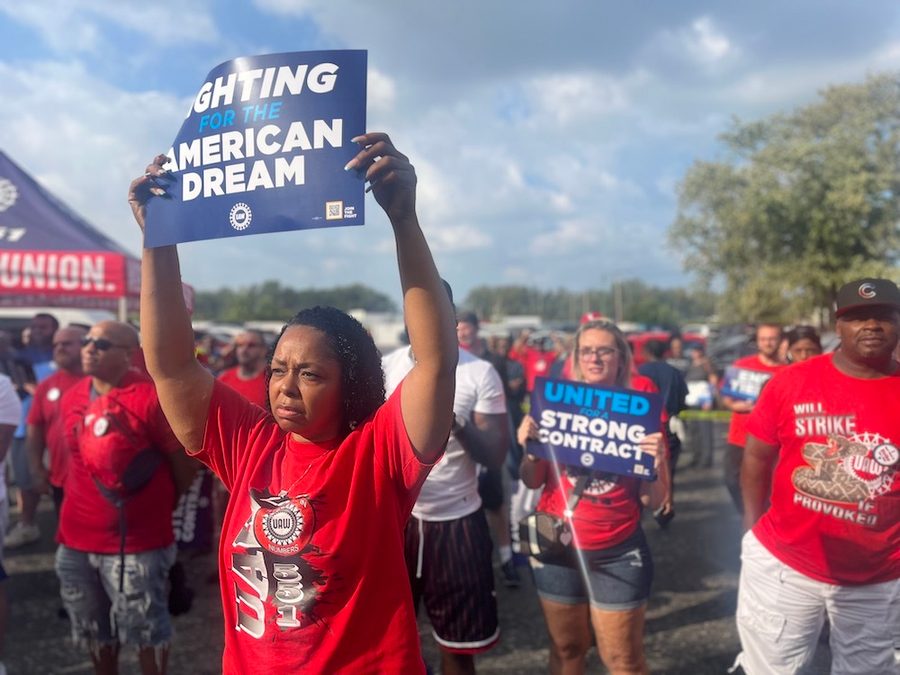
CHICAGO – Wearing a red United Auto Workers (UAW) t-shirt, Anastasia Gibson, 48, is warm and polite, quick to flash a broad smile. But her anger rises when she talks about her sacrifices to Ford, which made $10.4 billion in profits in 2022. Gibson works 10-hour shifts and injured her back on the job in 2021. “They don’t value anything we do. They want us to get as many cars off the line as we can.”
Such anger was palpable among the roughly 200 workers who gathered alongside Gibson in the late afternoon of September 6 outside the UAW Local 551 union hall in far southeastern Chicago, not far from the Indiana border. They were there to practice rallying and chanting for a picket line, in preparation for a possible strike as soon as midnight on September 14, when their union contract with Ford expires.
The golden sunshine slanted down on the crowd as it chanted, “Record profits equal record contracts!” Speakers addressed the crowd, among them Congressman Frank Mrvan (D-Ind.) and UAW Region 4 director Brandon Campbell, who proclaimed, “All they care about is their wealth and power. They’re too damn rich!”
Some of the union’s top demands are cost-of-living adjustments, an end to wage and benefit tiers based on hiring date, and an end to the mistreatment of temporary workers.
Those demands apply not just to Ford but to all the “Big Three” automakers — Ford, General Motors and Stellantis North America (the parent company of Chrysler and Jeep). UAW’s contracts with all three, covering some 146,000 workers, run out at the same time, a momentous opportunity for joint labor action across employers from a union that recently saw a big shift in leadership. Reform challenger Shawn Fain won the union presidency in March, calling for a new era of militancy, more democratic decision-making and new organizing.
Fain has struck a confrontational stance towards the Big Three automakers — and the wealthy class overall—criticizing the greed of corporate executives and making bold demands, like a 32-hour work week with no reduced pay. Other demands Fain has presented to all of the Big Three include enhanced profit sharing, improved wages, more paid time off and the right to strike over plants closing.
And as the Biden administration subsidizes a boom in electric-vehicle manufacturing, the union also wants a just transition to ensure electric vehicle jobs are good jobs and do not drive down labor conditions.
Workers at the Local 551 rally underscored the key demand to cap the use of temporary workers, who make lower pay and are the lowest tier of workers, used by the company to suppress labor costs. UAW wants to temporary workers to become permanent workers after 90 days, with full benefits and profit sharing.
Under the 2019 contracts that are about to expire, it takes two years for a temporary employee to convert. This feels like an eternity for Erron Hall, a temporary worker who started at the Chicago Assembly Plant in late November 2022, and is making just $16.67 an hour. This wage is difficult, he says, with the “cost of living going up.”
“This is my first time dealing with a strike,” Hall says, holding a sign that says “United for a Strong Contract,” and wearing one of many red shirts in the crowd. “It’s something new.”
Other picket signs read “End Tiers: No 2nd Class Workers,” reflecting another top issue for workers. Those who were hired following the 2007 contract suffered lower wages and poorer benefits, including the complete loss of pensions, which were swapped out for 401(k) accounts. The union wants a full restoration of pensions, a big issue for picketer Karla Hayes, a metal finisher who has been working at Ford for 13 years, starting after they took pensions away. “I’m 58 with no pension,” she says.
“When I took this job, it was not a traditional job for women,” Hayes continues.” (Overhearing this, her coworker, 39-year-old Robert Desmond, chimes in to say, “She does one hell of a job!”)
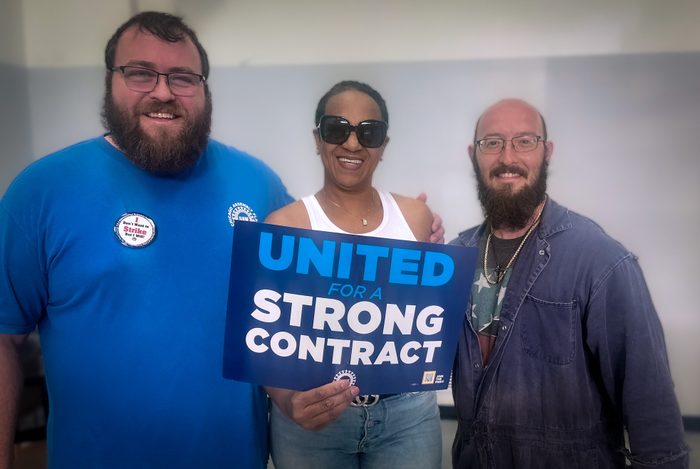
“I love my job,” Hayes says. “I have pride. I want them to show they have respect.”
UAW is also calling for more holidays and paid time off, which would be huge for Gibson. In her 11 years at Ford, Gibson says she has missed “tons of things” with her six children — awards ceremonies, field trips. She’s hoarding days off in hopes of making her son’s high school graduation this spring.
Polling shows that UAW workers have the overwhelming support of the public. A Gallup poll released on August 30 found that “three in four Americans … side with the United Auto Workers in their negotiations with U.S. auto companies.”
Ford worker Robert Kacher, 39, is a self-described “news junkie” who voted for Fain in the UAW presidential election. He read the poll online, but felt it viscerally when he marched in the Labor Day parade in Lowell, Ind. The crowd went wild when they saw the UAW contingent, he says. “They were very supportive of what we were going to do.”
Some of this community support is organized. The Chicago chapter of Democratic Socialists of America mobilized members to attend another “practice picket” on September 8.
UAW Local 551 also attracted at least one international supporter. Helene Cavat, a teacher from France, happened to be visiting friends in Chicago the week of the practice picket, and decided to trek out to show her support. She is an active member of France’s General Confederation of Labour, and wanted to show her solidarity. “We need more international exchanges,” she tells me.
While the outcome of contract talks remains uncertain, the workers gathered outside of the Local 551 office are clearly preparing to strike if needed. After the rally, workers clustered together to talk logistics with a strike captain. Flyers announced where non-perishable food and toiletries can be dropped off, to help relieve hardship for striking families. The mood was urgent and friendly, a combination of getting serious business done and catching up with coworkers.
Numerous workers I talked to say they are ready to do what’s necessary, in a struggle that has profound implications for their lives. “This place works a number on your body and soul,” says Anthony Romero, a 32-year-old worker at the Chicago Assembly Plant and a veteran of the U.S. war in Afghanistan. “That’s why I’m here.”
Gibson describes herself as “injured for life” from her 2021 workplace back injury, and estimates that a majority of her coworkers are in a similar position. “People here have carpal tunnel, rotator cuff injuries, back injuries. The work is hard and strenuous. There is wear and tear.”
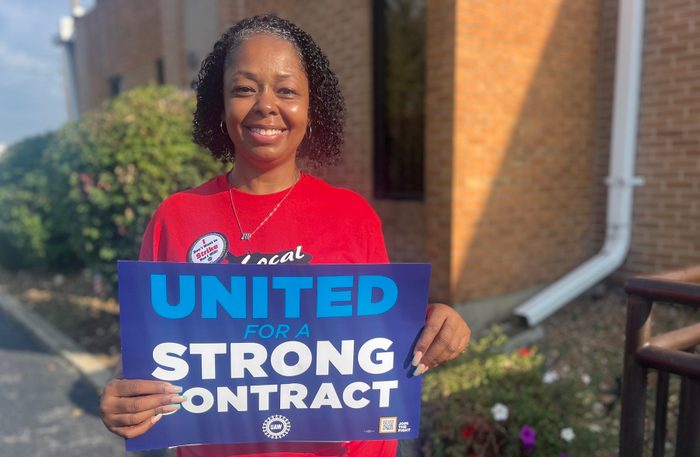
For all that, the money just isn’t enough, she says. “We are all really struggling. We’re in tough times. Prices are high. Going to the grocery store, you have to pick and choose what you eat.” Striking would make money even tighter, but she says she is ready.
But Fain’s public call for a 32-hour work week, whether it’s won in this contract or in the future, is her north star.
Right now she works 10-hour shifts, four days a week, some of them overnight. It takes her a full day of not working to unwind, she explains.
“For me it would be amazing,” she says. “It would allow me to get some rest.”
This article is a joint publication of In These Times and Workday Magazine, a non-profit newsroom devoted to holding the powerful accountable through the perspective of workers.
Sarah Lazare is the editor of Workday Magazine and a contributing editor for In These Times. She tweets at @sarahlazare.
